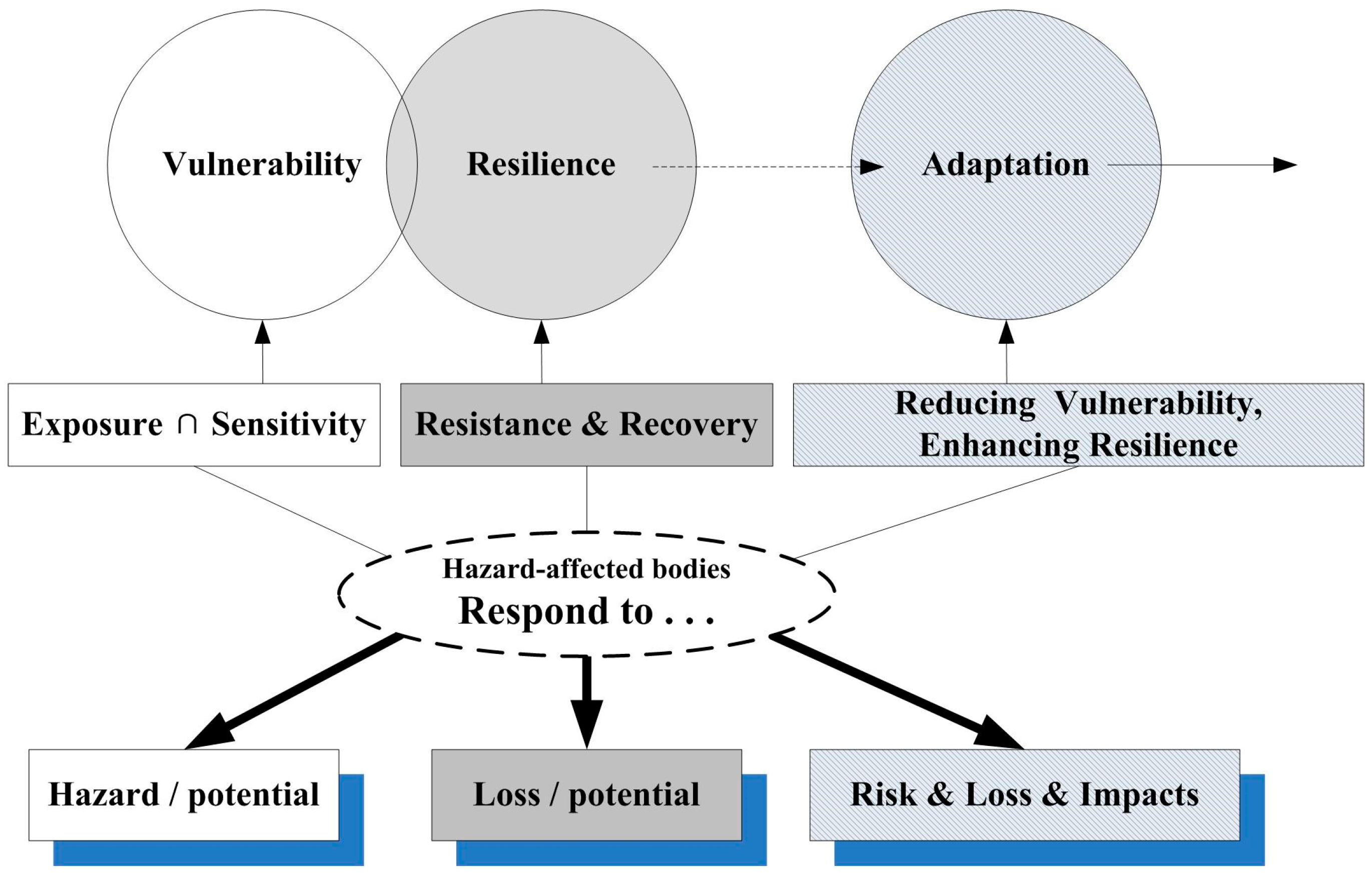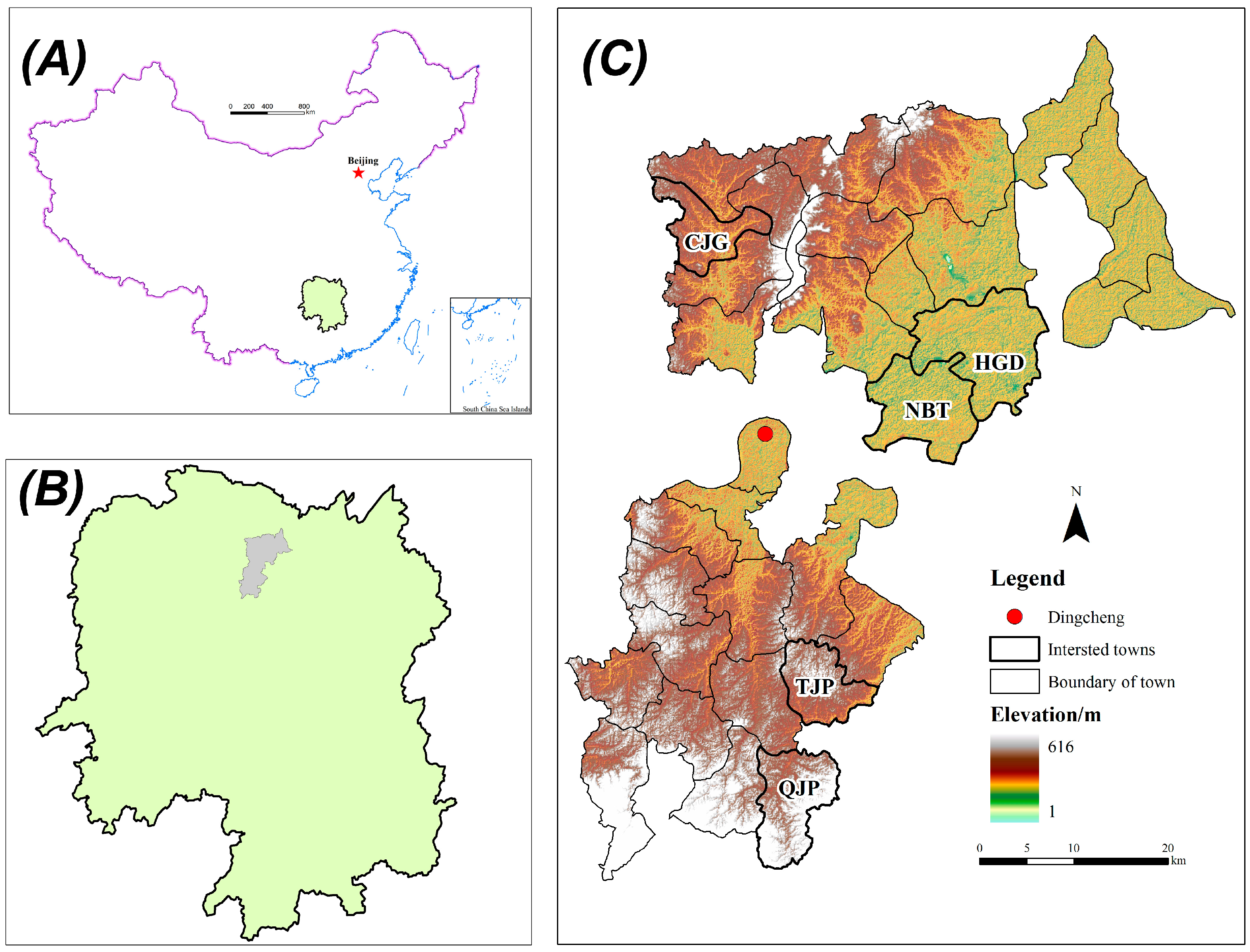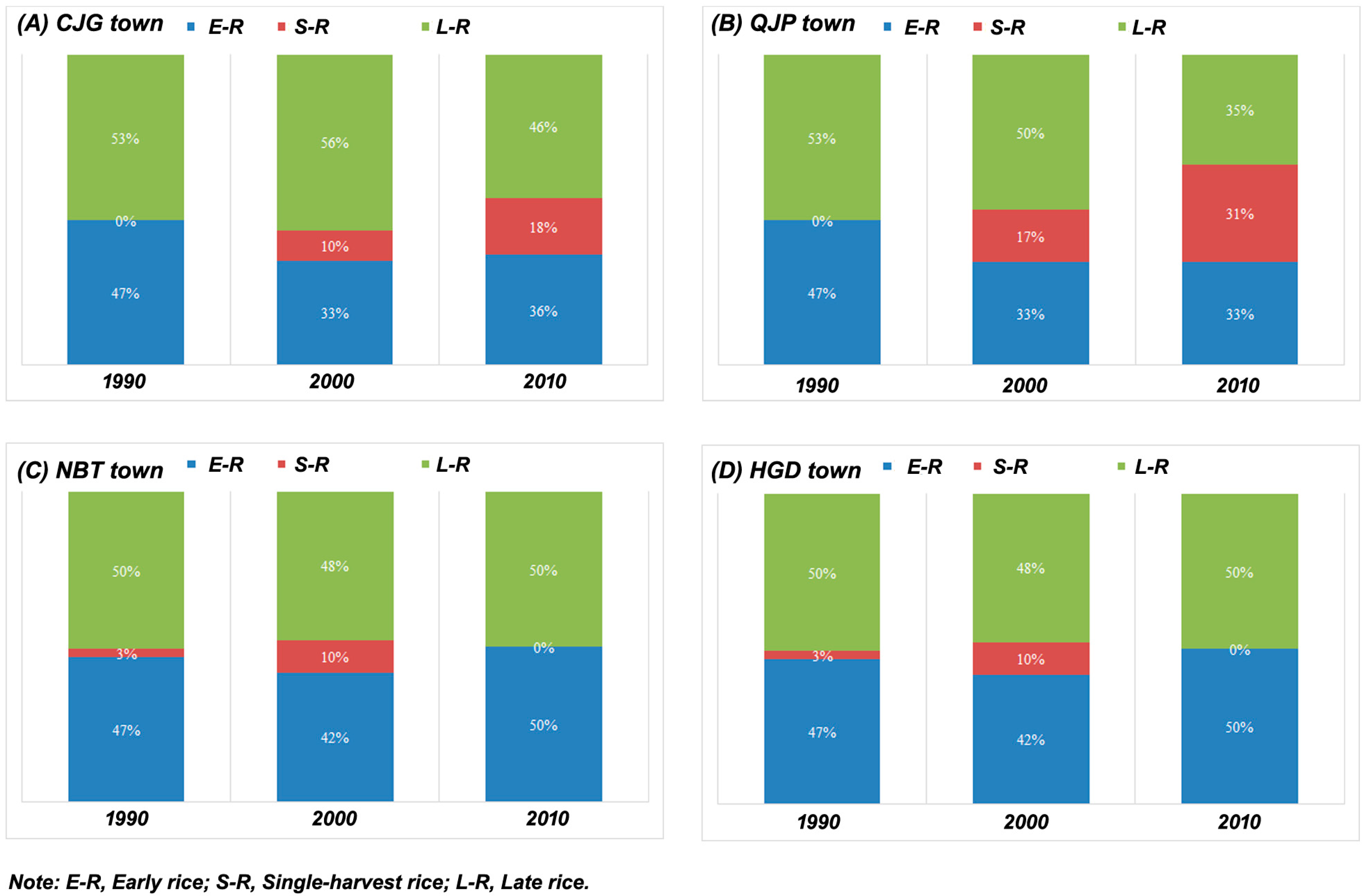A Way to Sustainability: Perspective of Resilience and Adaptation to Disaster
Abstract
:1. Introduction
2. Conceptual Variations between Adaptation and Resilience
2.1. Adaptation
2.2. Resilience
2.3. Relationship between Adaptation and Resilience
3. Case Study: Agricultural Drought Disaster in Dingcheng County of Southern China
3.1. Study Area
3.2. Material and Its Treatments
3.3. Land Use Change and Crop Structure Change
3.3.1. Land Use Change
3.3.2. Crop Structure Change
3.4. Land Policy Change and Labors Turnover
3.4.1. Land Policy
3.4.2. Labors Turnover
4. Discussions
4.1. The Target of Adaptation
4.2. The Deficiencies of Adaptation
4.2.1. Deficiencies of Human Resources
4.2.2. Deficiencies of Policy
4.2.3. Deficiencies of Technology
4.2.4. Deficiencies of Geographic Space
5. Conclusions
Acknowledgments
Author Contributions
Conflicts of Interest
References
- United Nations (UN). Global Assessment Report on Disaster Risk Reduction 2015. Available online: http://www.preventionweb.net/english/hyogo/gar/2015/en/home/GAR_2015/GAR_2015_2.html (accessed on 28 October 2015).
- Smit, B.; Wandel, J. Adaptation, adaptive capacity and vulnerability. Glob. Environ. Chang. 2006, 16, 282–292. [Google Scholar] [CrossRef]
- Holling, C.S. Resilience and stability of ecological systems. Annu. Rev. Ecol. Syst. 1973, 4, 1–23. [Google Scholar] [CrossRef]
- Adger, W.N. Vulnerability. Glob. Environ. Chang. 2006, 16, 268–281. [Google Scholar] [CrossRef]
- Zhou, H.; Wang, J.; Wan, J.; Jia, H. Resilience to natural hazards: A geographic perspective. Nat. Hazards 2010, 53, 21–41. [Google Scholar] [CrossRef]
- Sun, Y.; Zhou, H.; Wang, J.; Yuan, Y. Farmers’ response to agricultural drought in paddy field of southern China: A case study of temporal dimensions of resilience. Nat. Hazards 2012, 60, 865–877. [Google Scholar] [CrossRef]
- Winterhalder, G. Environmental analysis in human evolution and adaptation research. Hum. Ecol. 1980, 8, 135–170. [Google Scholar] [CrossRef]
- Denevan, W.M. Adaptation, variation and cultural geography. Prof. Geogr. 1983, 35, 399–406. [Google Scholar] [CrossRef]
- Lei, Y.; Wang, J.; Yue, Y.; Zhou, H.; Yin, W. Rethinking the relationships of vulnerability, resilience, and adaptation from a disaster risk perspective. Nat. Hazards 2014, 70, 609–627. [Google Scholar] [CrossRef]
- Shaw, R.; Pulhin, J.M.; Pereira, J.J. Climate Change Adaptation and Disaster Risk Reduction: Issues and Challenges; Emerald: Bingley, UK, 2010; pp. 1–19. [Google Scholar]
- Shaw, R.; Pulhin, J.M.; Pereira, J.J. Climate Change Adaptation and Disaster Risk Reduction: An Asian Perspective; Emerald: Bingley, UK, 2010; pp. 1–18. [Google Scholar]
- Kelman, I.; Gaillard, J.C.; Mercer, J. Climate change’s role in disaster risk reduction’s future: Beyond vulnerability and resilience. Int. J. Disaster Risk Sci. 2015, 6, 21–27. [Google Scholar] [CrossRef]
- Bogardi, J.J. Hazards, risks and vulnerabilities in a changing environment: The unexpected onslaught on human security? Glob. Environ. Chang. 2004, 14, 361–365. [Google Scholar] [CrossRef]
- Cutter, S.L.; Ash, K.D.; Emrich, C.T. The geographies of community disaster resilience. Glob. Environ. Chang. 2014, 29, 65–77. [Google Scholar] [CrossRef]
- Burton, I.; Kates, R.W.; White, G.F. The Environment as Hazard; Oxford University Press: New York, NY, USA, 1978; pp. 1–21. [Google Scholar]
- Stakhiv, E. Evaluation of IPCC Adaptation Strategies; Institute for Water Resources, U.S. Army Corps of Engineers: Fort Belvoir, VA, USA, 1993; pp. 1–200. [Google Scholar]
- Smith, K. Environmental Hazards: Assessing Risk and Reducing Disaster, 2nd ed.; Routledge: London, UK, 1996; pp. 1–15. [Google Scholar]
- Smit, B.; Burton, I.; Klein, R.J.T.; Wandel, J. An anatomy of adaptation to climate change and variability. Clim. Chang. 2000, 45, 223–251. [Google Scholar] [CrossRef]
- Adger, W.N.; Huq, S.; Brown, K.; Conwaya, D.; Hulmea, H. Adaptation to climate change in the developing world. Prog. Dev. Stud. 2003, 3, 179–195. [Google Scholar] [CrossRef]
- Brooks, N. Vulnerability, Risk and Adaptation: A Conceptual Framework. Available online: http://www.tyndall.ac.uk/sites/default/files/wp38.pdf (accessed on 28 October 2015).
- Young, O.R.; Berkes, F.; Gallopin, G.C.; Janssen, M.A.; Ostrom, E.; van der Leeuw, S. The globalization of socio-ecological systems: An agenda for scientific research. Glob. Environ. Chang. 2005, 16, 304–316. [Google Scholar] [CrossRef]
- Walker, B.; Holling, C.S.; Carpenter, S.R.; Kinzig, A. Resilience, adaptability and transformability in social-ecological systems. Ecol. Soc. 2004, 9, 3438–3447. [Google Scholar]
- Walker, B.; Abel, N.; Anderies, J.M.; Ryan, P. Resilience, adaptability, and transformability in the Goulburn-Broken Catchment, Australia. Ecol. Soc. 2009, 14, 12–35. [Google Scholar]
- UNISDR. Terminology on Disaster Risk Reduction. Available online: http://www.unisdr.org/eng/terminology/UNISDR-terminology-2009-eng.pdf (accessed on 28 October 2015).
- Folke, C.; Carpenter, S.R.; Walker, B.; Scheffer, M.; Chapin, T.; Rockström, J. Resilience thinking: Integrating resilience, adaptability and transformability. Ecol. Soc. 2010, 15, 20–28. [Google Scholar]
- McLaughlin, P. Climate change, adaptation, and vulnerability: Reconceptualizing societal-environment interaction within a socially constructed adaptive landscape. Organ. Environ. 2011, 24, 269–291. [Google Scholar] [CrossRef]
- IPCC (Intergovernmental Panel on Climate Change). Managing the Risks of Extreme Events and Disasters to Advance Climate Change Adaptation; Field, C.B., Barros, V., Stocker, T.F., Qin, D., Dokken, D.J., Ebi, K.L., Mastrandrea, M.D., Mach, K.J., Plattner, G.-K., Allen, S.K., et al., Eds.; Cambridge University Press: Cambridge, UK; New York, NY, USA, 2012. [Google Scholar]
- IPCC. IPCC Fifth Assessment Report. 2014. Available online: https://www.ipcc.ch/report/ar5/ (accessed on 28 October 2015).
- UNISDR (The United Nations Office for Disaster Risk Reduction). Sendai Framework for Disaster Risk Reduction 2015–2030. Available online: http://www.unisdr.org/files/43291_sendaiframeworkfordrren.pdf (accessed on 28 October 2015).
- Han, G.Y. Understanding Regional Dynamics of Vulnerability: A Historical Approach to the Flood Problem in China. Ph.D. Thesis, Graduate School of Geography, Clark University, Worcester, MA, USA, July 2011. [Google Scholar]
- Kusumastuti, R.D.; Husodo, Z.A.; Suardi, L.; Danarsari, D.N. Developing a resilience index towards natural disasters in Indonesia. Int. J. Disaster Risk Sci. 2014, 10, 281–291. [Google Scholar] [CrossRef]
- Aldunce, P.; Beilin, R.; Howden, M.; Handmer, J. Resilience for disaster risk management in a changing climate: Practitioners’ frames and practices. Glob. Environ. Chang. 2015, 30, 1–11. [Google Scholar] [CrossRef]
- White, G.F. Natural hazards research: Concepts, methods, and policy implications. In Natural Hazards: Local, National and Global; White, G.F., Ed.; Oxford University Press: New York, NY, USA, 1974. [Google Scholar]
- Cutter, S.L.; Barnes, L.; Berry, M.; Burton, C.; Evans, E.; Tate, E.; Webb, J. A place-based model for understanding community resilience to natural disasters. Glob. Environ. Chang. 2008, 18, 598–606. [Google Scholar] [CrossRef]
- Ding, Y. Monsoon over China; Kluwer Academic Publishers: Dordrecht, The Netherlands, 1994; p. 419. [Google Scholar]
- Shi, P.; Kasperson, R. World Atlas of Natural Disaster Risk; Beijing Normal University Press: Beijing, China, 2015; pp. 1–368. [Google Scholar]




| Year | Definitions | Category * | Citation |
|---|---|---|---|
| 1978 | Adaptation refers to the process, measures, or structural change in order to reduce or offset the potential disasters associated with climate change, or the use of the opportunities brought about by climate change, which include reducing the vulnerability of social, regional or activities on climate change and its variability. | CC | [15] |
| 1993 | The term adaptation means any adjustment, whether passive, reactive or anticipatory, that is proposed as a means for ameliorating the anticipated adverse consequences associated with climate change. | CC | [16] |
| 1996 | Adaptation to climate change includes all adjustments in behavior or economic structure that reduce the vulnerability of society to changes in the climate system. | CC | [17] |
| 2000 | Adaptation refers to the adjustments of ecological-social-economic system for the actual or foreseeable climate stimulate, their effects or impacts. | SESs | [18] |
| 2003 | Adaptation to climate change is the adjustment of a system to moderate the impacts of climate change, to take advantages of new opportunities or to cope with the consequences. | CC | [19] |
| 2003 | Adaptation means adjustments in a system’s behavior and characteristics that enhance its ability to cope with external stresses. Adaptation will allow a system to reduce the risk associated with these hazards by reducing its social vulnerability. | SESs | [20,21] |
| 2004 | Adaptability, a manifestation of adaptation, has been defined as “the capacity of actors in a system to influence resilience”. | SESs | [22,23] |
| 2006 | Adaptations include changes in the rules and governance of disaster risk, change in organizations, and promotion of self-mobilization in civil society and private corporations. | NH | [4] |
| 2009 | The adjustment in natural or human systems in response to actual or expected climatic stimuli or their effects, which moderates harm or exploits beneficial opportunities. | CC | [24] |
| 2010 | Adaptability is part of resilience. It represents the capacity to adjust responses to changing external drivers and internal processes and thereby allow for development along the current trajectory. | SESs | [25] |
| 2011 | Adaptation to climate is the process through which people reduce the adverse effects of climate on their health and well-being, and take advantage of the opportunities that their climatic environment provides. The term adaptation means any adjustment, whether passive, reactive or anticipatory. | CC | [26] |
| 2012 | In the context of climate change, adaptation is the adjustment in natural or human systems in response to actual or expected climatic stimuli or their effects, which moderates harm or exploits beneficial opportunities. | CC | [27] |
| 2014 | Adaptability is a manifestation of adaptation, which means the ability to absorb hazard impacts, prepare for, and recover from them. Adaptation in most cases is a proactive action to the anticipated hazards so that the potential negative effects or risks could be alleviated in advance. | NH | [9] |
| 2014 | Adaptation can reduce the risks of climate change impacts, but there are limits to its effectiveness, especially with greater magnitudes and rates of climate change. Taking a longer term perspective, in the context of sustainable development, increases the likelihood that more immediate adaptation actions will also enhance future options and preparedness. Adaptation is place- and context-specific, with no single approach for reducing risks appropriate across all settings (high confidence). | CC | [28] |
| 2015 | Incorporate disaster risk reduction measures into multilateral and bilateral development assistance programs within and across all sectors, as appropriate, related to poverty reduction, sustainable development, natural resource management, environment, urban development and adaptation to climate change. | NH | [29] |
| Year | Definitions | Category * | Citation |
|---|---|---|---|
| 2010 | From a geographic perspective, disaster resilience can be defined as the capacity of hazard-affected bodies (HABs) to resist loss during disaster and to regenerate and reorganize after disaster in a specific area in a given period. It can be conceived as both the loss potential and the biophysical/social response. Resilience can be classified as inherent resilience (IR), and adaptive resilience (AR). | NH | [5] |
| 2011 | A resilience approach requires not only changing the focus from modifying hazard events to reducing vulnerability. However, it is also essential to embrace and internalize variability and uncertainty in decision making. Which emphasizes the notion of “Building Resilience—Living with disasters”. | NH | [30] |
| 2012 | The ability of a system, community or society exposed to hazards to resist, absorb, accommodate to and recover from the effects of a hazard in a timely and efficient manner, including through the preservation and restoration of its essential basic structures and functions. | NH | [27] |
| 2012 | Disaster resilience also has the temporal dimension and it varies due to the relationship between the loss (potential) and response (potential) of hazard-affected bodies. | NH | [6] |
| 2014 | Resilience in disaster risk domain often expresses as the reactive responses to a specific disaster. It embodies the ability to resist, absorb, accommodate to, and recover from the effects of a hazard in a timely and efficient manner. | NH | [8] |
| 2014 | Resilience is defined as the ratio between preparedness and vulnerability. The dimensions for preparedness are social, economic, community capacity, institutional and infrastructure. Similar dimensions applied for the vulnerability with additional dimension of hazard, come up with an index that is scaled from 0 to 1. | NH | [31] |
| 2014 | Inherent resilience and its drivers are spatially variable. Resilience and vulnerability are statistically related, but not the obverse of one another. | NH and CC | [32] |
| 2015 | About resilience, there is a focus on learning, but it is pertinent to move from experiential learning toward social learning. | SESs | [33] |
| 2015 | Public and private investment in disaster risk prevention and reduction through structural and non-structural measures are essential to enhance the economic, social, health and cultural resilience of persons, communities, countries and their assets, as well as the environment. | NH and SESs | [29] |
| Name | Topography | Population | Cropland | Rice Planting Proportion | Income per Capita/RMB | Main Income | |||||
|---|---|---|---|---|---|---|---|---|---|---|---|
| Total Size | Proportion of Agriculture | Proportion of Female | Proportion of Labor | Total Area/ha | Paddy:Rainfed | Double Harvest Rice | Single Harvest Rice | ||||
| NBT | Plain/lake area | 39,364 | 90% | 49% | 68% | 2828 | 95:5 | 100 | 0 | 3745 | Vegetables and aquaculture |
| HGD | Plain/river area | 47,782 | 95% | 49% | 67% | 3887 | 90:10 | 100 | 0 | 3410 | Rice production |
| TJP | Hill area | 17,088 | 98% | 48% | 66% | 1390 | 94:6 | 100 | 0 | 3263 | Migrant workers’ income |
| QJP | Mountain area | 15,112 | 98% | 49% | 67% | 1064 | 98:2 | 55 | 45 | 3523 | Economic forest |
| CJG | Mountain area | 17,098 | 95% | 50% | 69% | 1364 | 97:3 | 58 | 42 | 3928 | Economic forest |
© 2016 by the authors; licensee MDPI, Basel, Switzerland. This article is an open access article distributed under the terms and conditions of the Creative Commons Attribution (CC-BY) license (http://creativecommons.org/licenses/by/4.0/).
Share and Cite
Zhou, H.; Wang, X.; Wang, J. A Way to Sustainability: Perspective of Resilience and Adaptation to Disaster. Sustainability 2016, 8, 737. https://doi.org/10.3390/su8080737
Zhou H, Wang X, Wang J. A Way to Sustainability: Perspective of Resilience and Adaptation to Disaster. Sustainability. 2016; 8(8):737. https://doi.org/10.3390/su8080737
Chicago/Turabian StyleZhou, Hongjian, Xi Wang, and Jing’ai Wang. 2016. "A Way to Sustainability: Perspective of Resilience and Adaptation to Disaster" Sustainability 8, no. 8: 737. https://doi.org/10.3390/su8080737






